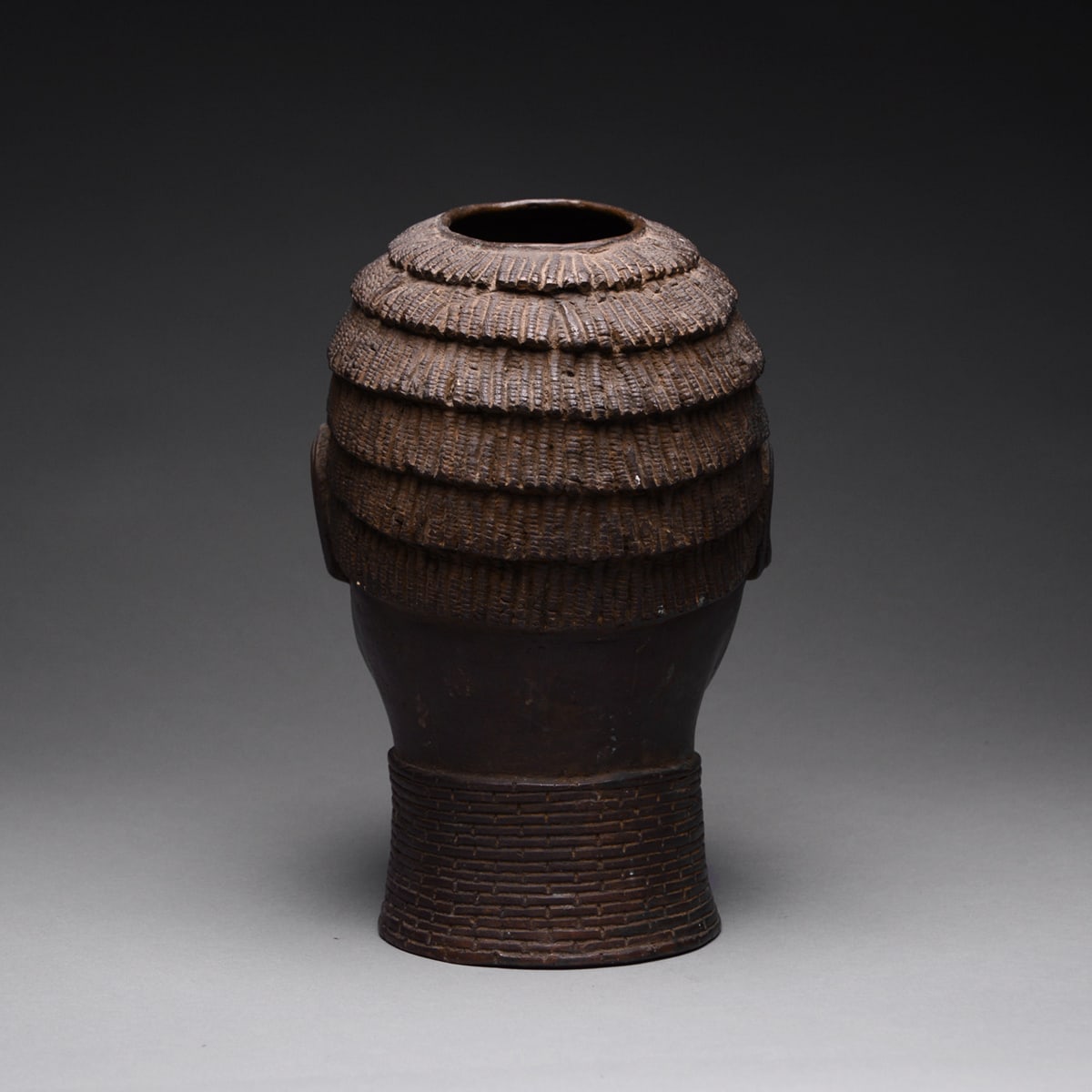Benin Bronze Head, 1800 CE - 1900 CE
bronze
height 24.1 cm
height 9 1/2 in
height 9 1/2 in
DG.027 (LSO)
Further images
This striking brass head represents an Oba, one of the hereditary God-Kings of the Benin Empire. It also displays characteristics associated with Iyobas – queen mothers – notably the quadruple...
This striking brass head represents an Oba, one of the hereditary God-Kings of the Benin Empire. It also displays characteristics associated with Iyobas – queen mothers – notably the quadruple pellets over each eye, but the set of the features are undeniably male. The face is full, representing a well-nourished individual with almost diamond-shaped eyes, a sharp nose and large, pouting lips. The ears are rendered as shell-like geometric shapes. The eyes and the double scarification on the forehead were once inlaid with iron.
In the eyes of the Benin populace, the Obas were divine beings, and these heads were created after their demise in order to be displayed on altars dedicated to their memory. Until the late 19th century, the Benin centres were a ruling power in Nigeria, dominating trade routes and amassing enormous wealth as the military and economic leaders of their ancient empire. This changed with the appearance of British imperial forces, which coveted the wealth of the royal palaces and found a series of excuses to mount a punitive expedition against the Oba’s forces in 1897. It was only at this point, the moment of its’ destruction, that the true achievements of the Benin polities became apparent to western scholars.
Benin royal palaces comprised a sprawling series of compounds containing accommodation, workshops and public buildings. As it grew, the buildings pertaining to previous Obas were either partially refurbished or left in favour of newer constructions; this led to a long history of royal rule written in sculptural works that rank among the finest that African cultures have ever produced; until European advances in the 19th century, they were the finest bronzes that had ever been made. Brass or bronze Oba heads were used to honour the memory of a deceased king. Typically, the son of the dead king – the new Oba – would pay tribute to his father by erecting an altar in his memory. These altars, low platforms of mud that were arrayed around the perimeter of the royal courtyards, were decorated with various artefacts alluding to the Oba’s achievements in life.
Benin brass heads were made throughout the empire’s duration. Yet while this is a comparatively late example it is easy to see why the Benin artists were deemed to be among the world’s greatest in this medium. This is a striking piece of Benin art.
Ezra, K. 1992. Royal Art of Benin: the Perls Collection. Metropolitan Museum of Art, NYC, US.
Bacquart, J. 1998. The Tribal Arts of Africa. Thames and Hudson, UK.
Phillips, T. (ed). 1999. Africa: The Art of a Continent. Prestel.
In the eyes of the Benin populace, the Obas were divine beings, and these heads were created after their demise in order to be displayed on altars dedicated to their memory. Until the late 19th century, the Benin centres were a ruling power in Nigeria, dominating trade routes and amassing enormous wealth as the military and economic leaders of their ancient empire. This changed with the appearance of British imperial forces, which coveted the wealth of the royal palaces and found a series of excuses to mount a punitive expedition against the Oba’s forces in 1897. It was only at this point, the moment of its’ destruction, that the true achievements of the Benin polities became apparent to western scholars.
Benin royal palaces comprised a sprawling series of compounds containing accommodation, workshops and public buildings. As it grew, the buildings pertaining to previous Obas were either partially refurbished or left in favour of newer constructions; this led to a long history of royal rule written in sculptural works that rank among the finest that African cultures have ever produced; until European advances in the 19th century, they were the finest bronzes that had ever been made. Brass or bronze Oba heads were used to honour the memory of a deceased king. Typically, the son of the dead king – the new Oba – would pay tribute to his father by erecting an altar in his memory. These altars, low platforms of mud that were arrayed around the perimeter of the royal courtyards, were decorated with various artefacts alluding to the Oba’s achievements in life.
Benin brass heads were made throughout the empire’s duration. Yet while this is a comparatively late example it is easy to see why the Benin artists were deemed to be among the world’s greatest in this medium. This is a striking piece of Benin art.
Ezra, K. 1992. Royal Art of Benin: the Perls Collection. Metropolitan Museum of Art, NYC, US.
Bacquart, J. 1998. The Tribal Arts of Africa. Thames and Hudson, UK.
Phillips, T. (ed). 1999. Africa: The Art of a Continent. Prestel.







